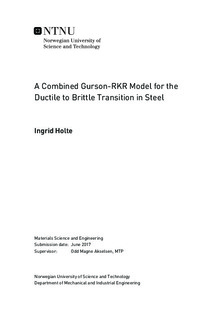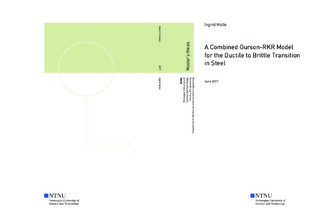| dc.description.abstract | The goal of this work was to establish a simulation scheme that incorporates both ductile and brittle fracture modes with respect to temperature in order to describe the aforementioned toughness dependency on temperature. Whether or not changing only temperature and constraint level would be sufficient to show the ductile-to-brittle transition without incorporating ductile material softening through the Gurson model was investigated. It was found that a stress-criterion alone would not capture the transition of material behaviour.
The complete Gurson model was used to simulate softening induced ductile tearing in ABAQUS. The model was incorporated through a user subroutine, UMAT. Simulations for three different temperatures (21 degree C, 0 degree C and -60 degree C) were run. Fracture resistance curves for all temperatures were plotted from the simulations and compared to experimental data. From this the ductile-to-brittle transition as captured by the complete Gurson model could be plotted. As the model was fitted from the highest temperature, 21 degree C, the fit was very good and the model predicted both CTOD and Da-values here. However, the Gurson model is not able to capture the brittle characteristics that appear at lower temperatures, and the results clearly deviated at both 0 degree C and -60 degree C.
To account for cleavage, a brittle stress criterion, the RKR-criterion, was applied as a post-processing routine. The input parameters for the criterion were fitted from -60 degree C, and the prediction of CTOD at this temperature from simulations was very good. A parametric study of the input parameters for the RKR-criterion has been conducted. The length scale, which should be tied with microstructure, was used as a material fitting parameter.
The combined Gurson+RKR model severely overestimated brittleness at high temperatures and needed a competing criterion to determine if cleavage has occurred or not. The CTOD at the increment in the simulation corresponding to the maximum force of the characteristic experimental value was used for this. The resulting ductile-to-brittle transition curve gave accurate results at both the upper and lower shelf, and satisfactory, if somewhat conservative, results in the intermediate region. The model captured the change of fracture mechanism over the temperature range from -60 degree C to 21 degree C. The model still needs some improvement. Some of the material parameters have been detached from their physical value and used as fitting parameters. The simulated DBT-curve is not uniquely determined, but can be shifted. | |

